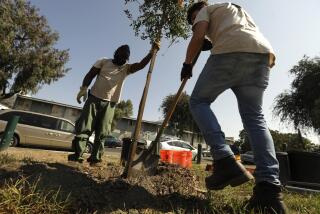Too poor? Look again
- Share via
Community leaders in South Los Angeles who try to recruit new retailers often get turned down because businesses can’t see past the poverty in these neighborhoods. Why would a company gamble on a location where shoppers can’t afford to buy the things on the shelves? And with images in the media of crime scenes and dilapidated commercial centers reinforcing the perception of blight, retailers’ concerns have been hard to rebut.
A new study by Social Compact, a nonprofit research group in Washington, could give South and East L.A. the data they need to overcome that reluctance. The group examined nine communities, including Crenshaw, Boyle Heights and Watts, for evidence that census figures underestimated the number of residents and their buying power. City building, tax and water records helped demonstrate that far more people lived in those neighborhoods than previously estimated. And data from credit bureaus, combined with a survey of underground economies and informal financial systems (such as the number of check-cashing outlets), led the researchers to project average household incomes that were significantly higher than the government’s numbers.
The study found several other indications of dormant or squandered buying power. For example, it estimated that almost 60% of the residential buildings were owner occupied, the mean home sale value was $440,000, and total income in the nine neighborhoods was $5.5 billion. Those numbers were double to triple the values reported in the 2000 census. And the neighborhoods are so underserved by supermarkets that $113 million is spent annually on food from stores in other areas. But the new estimates for population and household income alone should help put those nine communities back on retailers’ maps. After all, according to a separate study by Social Compact and the International Council of Shopping Centers, those two factors drive many retailers’ choice of where to locate in a market.
Granted, the numbers won’t eliminate the other hurdles to plunking down a sizable new store in, say, West Adams or Leimert Park, such as small lots, insufficient parking and higher security costs. That’s why retailers have taken what seems like the path of least resistance, locating in the suburbs instead of the inner city. With gasoline surging above $4 a gallon, though, it’s past time for retailers to turn their attention inward. Too often, city neighborhoods have been rejected because retailers focused on their liabilities. The Social Compact study should help them see the other side of the equation -- the assets and the opportunities they’ve been missing.
More to Read
Inside the business of entertainment
The Wide Shot brings you news, analysis and insights on everything from streaming wars to production — and what it all means for the future.
You may occasionally receive promotional content from the Los Angeles Times.










